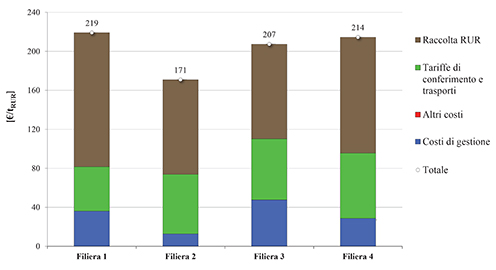LIFE CYCLE COSTING OF ENERGY PRODUCTION FROM THE RESIDUAL WASTE BASED ON MECHANICAL BIOLOGICAL PRETREATMENT
Main Article Content
Abstract
This study is aimed at analysing the energy supply chain based on the treatment of the Residual Waste (RW) in mechanical-biological plants (MBT) to generate material streams, such as Solid Recovered Fuels (SRF) or dried fractions, that have the energy potential exploitable in dedicated power plants for electric and thermal energy production or in co-combustion in industrial facilities (cement plants or thermoelectric power plants). Italy represents the geographical context of the study, with a focus on the year 2015.
The Life Cycle Costing (LCC) methodology has been applied, which allows to estimate the overall treatment costs according to the type of plant and to the destiny of the output streams and to make some considerations about the most convenient economic alternative. To get primary data, a questionnaire was sent to some selected MBT plants. By processing the gathered data, the main peculiarities of each type of MBT technology (single and separated streams) and of the outgoing streams were evaluated.
In particular, four strategies were analysed: 1. single-stream MBT followed by SRF co-combustion in cement kiln, 2. single-stream MBT followed by SRF combustion in fluidised bed waste-to-energy (WTE) plants, 3. single-stream MBT followed by SRF combustion in fluidised bed and grate WTE plants, and 4. MBT with streams separation followed by SRF combustion in fluidised bed WTE plants.
Considering the dual role of MBT plants, i.e. on the one hand they represent a form of treatment of the RW and on the other they are a tool for the production of a fuel destined to energy recovery, the Environmental LCC was performed considering two different functional units: 1 tonne of RW at the entrance of the MBT plant, and 1 MWh of exergy produced by the energy valorisation of the flows leaving the MBT plant. The LCC included the internal costs, i.e. operational and maintenance costs, the capital investment, end-of-life costs and costs for insurances, costs of transport and treatment of the MBT output flows.
When the functional unit is 1 tonne of RW entering the MBT plant, strategies 1 and 4 resulted the most expensive (219 and 214 €/tRW, respectively). When the functional unit is 1 MWh of produced exergy, the results suggest that the strategy based on the single-stream MBT followed by SRF co-combustion (i.e. strategy 1) is the best one from the economic point of view: in fact, while for the strategy 1 the total costs are 68 €/MWhex, strategies 2, 3 and 4 sustained in 2015 higher costs, respectively equal to 330, 308 and 1,079 €/MWhex. The highest cost is therefore that associated with strategy 4, based on a separated-stream MBT: therefore, if we consider the cost to produce 1 MWh of exergy, the treatment of waste in this type of MBT is the most expensive. Moreover, it resulted that 570 kg of RW are needed to produce 1 MWh of exergy in strategy 1, while 8,520 kg of RW are required to produce 1 MWh of exergy in strategy 4. In this regard, it can be concluded that promoting waste treatment in single-stream MBT plants reduces the costs for the disposal of difficult-to-manage flows (wet fraction to stabilize and dispose of) on the one hand, and on the other allows to produce a high-quality SRF well suitable for co-combustion, with consequent energy savings from fossil fuels.
Since the LCC has been calculated as an Environmental LCC, the obtained results could be integrated with a Life Cycle Assessment (LCA) of the same system, in order to get both an economic and an environmental evaluation.

